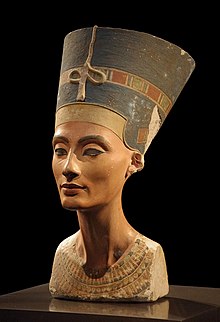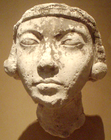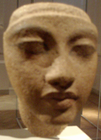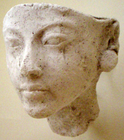art.wikisort.org - Artista
Thutmose (... – ...; fl. 1340 a.C. ± 50 anni) è stato un capo-scultore egizio durante il tardo periodo del regno di Akhenaton, faraone della XVIII dinastia egizia.

Scoperta
Nel dicembre 1912 una spedizione archeologica tedesca rinvenne, durante dei lavori di scavo tra le rovine di Akhetaton - la città voluta da Akhenaton - un edificio (etichettato come P 47) che venne interpretato come l'abitazione e il laboratorio di uno scultore[1]. Tra un cumulo di rifiuti nel cortile dell'abitazione venne ritrovato un oggetto in avorio
Thoth-ms-s
seguito dai titoli di Favorito del Re e Maestro dei lavori. Come conseguenza di tale ritrovamento, la casa e lo studio annesso vennero attribuiti a questo personaggio[2].
Thutmose fu uno scultore del periodo della XVIII dinastia
Opere
Tra i vari oggetti d'arte scultorea recuperati dalle stanze del laboratorio, quello di gran lunga più conosciuto è il celebre busto policromo della Grande Sposa Reale Nefertiti, ritenuto un modello originale destinato ad altri scultori perché ne facessero delle copie.
Oltre a questo famoso busto, vennero ritrovati una ventina di calchi in stucco di volti e di teste[1]; in alcune di queste opere sono stati identificati svariati membri della famiglia reale tra cui Akhenaton stesso, l'altra sua moglie Kiya, il padre Amenhotep III ed il funzionario e futuro faraone Ay[1].
Un paio di pezzi rinvenuti nel laboratorio ritraggono nobildonne visibilmente avanti con gli anni: un caso assai insolito nell'arte egizia, dove queste venivano normalmente idealizzate come bellissime giovani a prescindere dalla loro reale età[3]. Uno dei volti di stucco rappresenta una donna di una certa età con profonde rughe sulla fronte, pieghe all'estremità degli occhi e vere e proprie "borse" sotto a questi. Questo pezzo è stato descritto come avente "una varietà di rughe maggiore di qualunque altra rappresentazione di nobildonna dell'antico Egitto"[4].
Nel laboratorio si rinvenne anche una statuetta rappresentante una non più giovane Nefertiti, raffigurata con il ventre cascante, le cosce ingrossate e una linea curva alla base dell'addome, quasi a voler dare conferma dei numerosi bambini che la regina diede alla luce, forse per trasmettere un'idea di fertilità[5].
Molte delle opere attribuite a Thutmose sono oggi esposte all'Ägyptisches Museum und Papyrussammlung di Berlino, al Museo egizio del Cairo e al Metropolitan Museum of Art di New York.
Galleria d'immagini
 Volto in stucco di un'anziana donna, databile tra il 14º-17º anno di regno di Akhenaton. Berlino, Ägyptisches Museum und Papyrussammlung.
Volto in stucco di un'anziana donna, databile tra il 14º-17º anno di regno di Akhenaton. Berlino, Ägyptisches Museum und Papyrussammlung. Volto in stucco di giovane donna (forse Kiya, una sposa di Akhenaton), databile al tardo regno di Akhenaton. New York, Metropolitan Museum of Art.
Volto in stucco di giovane donna (forse Kiya, una sposa di Akhenaton), databile al tardo regno di Akhenaton. New York, Metropolitan Museum of Art. Ritratto che si ritiene rappresenti Kiya. Berlino, Ägyptisches Museum und Papyrussammlung.
Ritratto che si ritiene rappresenti Kiya. Berlino, Ägyptisches Museum und Papyrussammlung. Ritratto che si ritiene rappresenti Amenhotep III, il padre di Akhenaton. Berlino, Ägyptisches Museum und Papyrussammlung.
Ritratto che si ritiene rappresenti Amenhotep III, il padre di Akhenaton. Berlino, Ägyptisches Museum und Papyrussammlung. Ritratto in stucco ritenuto rappresentare Ay, che diventerà faraone verso la fine della dinastia. Berlino, Ägyptisches Museum und Papyrussammlung.
Ritratto in stucco ritenuto rappresentare Ay, che diventerà faraone verso la fine della dinastia. Berlino, Ägyptisches Museum und Papyrussammlung. Statuetta in pietra calcarea di Nefertiti. Berlino, Ägyptisches Museum und Papyrussammlung.
Statuetta in pietra calcarea di Nefertiti. Berlino, Ägyptisches Museum und Papyrussammlung. Ritratto in stucco attribuito a Nefertiti. Berlino, Ägyptisches Museum und Papyrussammlung.
Ritratto in stucco attribuito a Nefertiti. Berlino, Ägyptisches Museum und Papyrussammlung. Testa in granito di Nefertiti. Berlino, Ägyptisches Museum und Papyrussammlung.
Testa in granito di Nefertiti. Berlino, Ägyptisches Museum und Papyrussammlung.
Note
- Rolf Krauss, Why Nefertiti went to Berlin, in KMT, vol. 19, n. 3, 2008, pp. 44-53.
- Reeves (2005), p. 157
- Sweeney (2004), p. 67
- Sweeney (2004), p. 79
- Joyce Tyldesley, Chronicle of the Queens of Egypt, Thames & Hudson, 2006, pp. 126-127, ISBN 0-500-05145-3.
Bibliografia
- Cyril Aldred, Akhenaten: King of Egypt, Thames & Hudson, 1988, p. 59.
- Aidan Dodson, Amarna Sunset: Nefertiti, Tutankhamun, Ay, Horemheb, and the Egyptian Counter-Reformation, The American University in Cairo Press, 2009, ISBN 978-977-416-304-3. (rif: Reeves (2005))
- Rita E. Freed, Yvonne J. Markovitz & Sue H. D'Auria, Pharaohs of the Sun: Akhenaten - Nefertiti - Tutankhamen, Museum of Fine Arts, 1999, pp. 123-126.
- Deborah Sweeney, Forever Young? The Representation of Older and Ageing Women in Ancient Egyptian Art, in Journal of the American Research Center in Egypt, vol. 41, 2004, pp. 67-84.
Altri progetti
 Wikimedia Commons contiene immagini o altri file su Thutmose
Wikimedia Commons contiene immagini o altri file su Thutmose
| Controllo di autorità | VIAF (EN) 567149919424106650007 · Europeana agent/base/63013 · GND (DE) 1136127313 · WorldCat Identities (EN) viaf-567149919424106650007 |
|---|
На других языках
[de] Thutmosis (Bildhauer)
Thutmosis, auch Thutmose oder Djehutimes, war Bildhauer, zuweilen auch als Oberbildhauer bezeichnet, zur Zeit des Pharaos Echnaton in der 18. Dynastie (Neues Reich). Sein Name und Titel Thutmosis, Liebling des guten Gottes, Aufseher der Arbeiten und Bildhauer[1] sind auf dem Fragment einer kleinen Scheuklappe aus Elfenbein belegt, die sich mit der Inventar-Nr. 21193 im Ägyptischen Museum Berlin befindet und in Tell el-Amarna in Haus P 47,2 gefunden wurde.[en] Thutmose (sculptor)
Thutmose, also known as "The King's Favourite and Master of Works, the Sculptor Thutmose" (also spelled Djhutmose, Thutmosis, and Thutmes), was an Ancient Egyptian sculptor. He flourished around 1350 BC, and is thought to have been the official court sculptor of the Egyptian pharaoh Akhenaten in the latter part of his reign. A German archaeological expedition digging in Akhenaten's deserted city of Akhetaten, known today as Amarna, found a ruined house and studio complex (labeled P47.1-3)[1] in early December 1912;[2] the building was identified as that of Thutmose based on an ivory horse blinker found in a rubbish pit in the courtyard inscribed with his name and job title.[3] Since it gave his occupation as "sculptor" and the building was clearly a sculpture workshop, the determination seemed logical and has proven to be accurate.[es] Tutmose (escultor)
Tuthmose o Dyehutymose (engendrado por Dyehuty) (circa 1330 a. C.) fue un artesano y maestro escultor y pintor durante el reinado de Akenatón, que tenía un taller de escultura en la ciudad de Amarna. Fue en dicho lugar donde se han encontrado numerosas «cabezas de reserva» de la reina Nefertiti.[fr] Thoutmôsis (sculpteur)
Thoutmôsis (ou Djéhoutymosé, Thoutmès) est supposé être le sculpteur officiel du pharaon Akhenaton à la fin de son règne. Une expédition archéologique allemande mené par Ludwig Borchardt en 1912, en fouillant l'ancienne capitale amarnienne Amarna, a trouvé une maison et un atelier en ruine (répertorié P47.1-3). Ce complexe semble avoir appartenu à un certain Thoutmôsis ; cette hypothèse formulée par Borchardt se base sur une inscription découverte sur une petite œillère en ivoire (élément d'un harnais d'un cheval) trouvée dans une fosse à ordures dans la cour[1].- [it] Thutmose (scultore)
[ru] Тутмос (скульптор)
Тутмос-младший (Тутмес-младший, собственно Джехутимесу) — древнеегипетский скульптор периода поздней XVIII династии (середина XIV в. до н. э.). Работал при дворе фараона Эхнатона (Аменхотепа IV) в городе Ахетатоне (вероятно, Тутмос находился под началом главного придворного скульптора Бека или Бака), являясь ярким представителем амарнского искусства. Один из немногих древнеегипетских художников, чьё имя известно потомкам.Другой контент может иметь иную лицензию. Перед использованием материалов сайта WikiSort.org внимательно изучите правила лицензирования конкретных элементов наполнения сайта.
WikiSort.org - проект по пересортировке и дополнению контента Википедии






